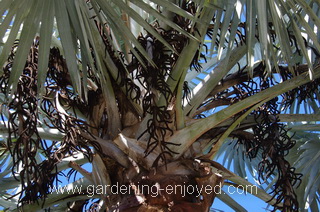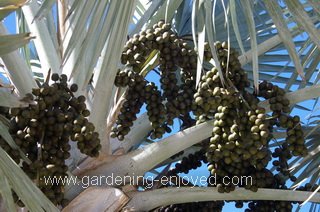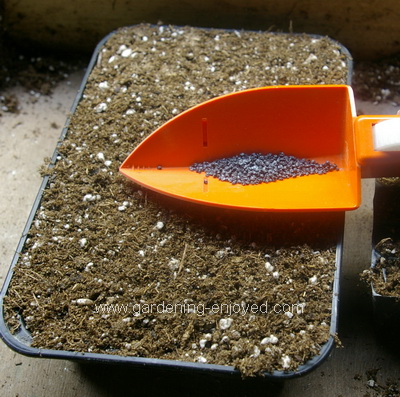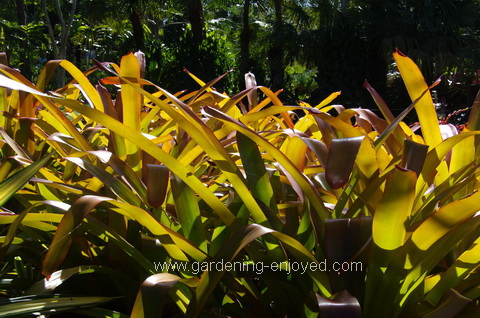| Back to Back Issues Page |
 |
|
Dallying In The Dirt, Issue #283 - A happy visit to the Naples Botanical Garden enriches our holiday February 16, 2017 |
 The other plant family that was widely represented is the Palm family. It’s probably my home in the temperate world of Maple syrup that creates my fascination with Palms and their many species. Most people can recognize a Coconut Palm particularly if there is a large group of fruit hanging down from the base of the fronds. There are about 2600 species
The other plant family that was widely represented is the Palm family. It’s probably my home in the temperate world of Maple syrup that creates my fascination with Palms and their many species. Most people can recognize a Coconut Palm particularly if there is a large group of fruit hanging down from the base of the fronds. There are about 2600 species  of Palm world wide and they are an economically important family providing food, shelter and fabric in many parts of the world. They are also widely used as decorative subjects in tropical parts of the world and that is primarily where my interest lies although I do enjoy dates and coconuts. The Naples Botanical Garden was a delight for me because of its Palm collection. With 2600 species to choose from it’s hard for any collection to be called extensive or anywhere near complete but they did have a large number of species including one of my favourites Bismarckia nobilis The real delight, for me, was a planting of four trees side by side that readily displayed the dioecious (separate male and female trees) nature of this large leaved beauty. There were two boys and two girls growing in a row and the pictures show fruit being produced by the girl and the smaller pollen producing flowers of the boy. I’m self
confessed plant nerd that can actually get excited about such things.
of Palm world wide and they are an economically important family providing food, shelter and fabric in many parts of the world. They are also widely used as decorative subjects in tropical parts of the world and that is primarily where my interest lies although I do enjoy dates and coconuts. The Naples Botanical Garden was a delight for me because of its Palm collection. With 2600 species to choose from it’s hard for any collection to be called extensive or anywhere near complete but they did have a large number of species including one of my favourites Bismarckia nobilis The real delight, for me, was a planting of four trees side by side that readily displayed the dioecious (separate male and female trees) nature of this large leaved beauty. There were two boys and two girls growing in a row and the pictures show fruit being produced by the girl and the smaller pollen producing flowers of the boy. I’m self
confessed plant nerd that can actually get excited about such things. Eventually all holidays end and we have to return home. The Begonia Seeds that had germinated before I left survived my absence. They had been well watered and then put under a clear plastic lid to keep the humidity high. The Geraniums also survived and now are in need of a pruning. I take a few cuttings in the fall and then take more cuttings from these plants as they grow during the winter. That usually leaves me with more Geraniums than I actually need but throwing out good cuttings when I’m pruning them is just not something I seem to be able to do. Now to get busy with the many other seeds that need to be started. Onions and Leeks are the first to find their way into the soil and that will happen today, or possibly tomorrow. I
sow them into a common seed tray and they will stay there until they are separated to be planted into the garden. I have tried planting them in individual cells but that took up too much space and didn’t seem to give me any great advantage in the garden. Some of my experiments yield great new techniques and some remain as interesting experiments and that’s gardening.
Eventually all holidays end and we have to return home. The Begonia Seeds that had germinated before I left survived my absence. They had been well watered and then put under a clear plastic lid to keep the humidity high. The Geraniums also survived and now are in need of a pruning. I take a few cuttings in the fall and then take more cuttings from these plants as they grow during the winter. That usually leaves me with more Geraniums than I actually need but throwing out good cuttings when I’m pruning them is just not something I seem to be able to do. Now to get busy with the many other seeds that need to be started. Onions and Leeks are the first to find their way into the soil and that will happen today, or possibly tomorrow. I
sow them into a common seed tray and they will stay there until they are separated to be planted into the garden. I have tried planting them in individual cells but that took up too much space and didn’t seem to give me any great advantage in the garden. Some of my experiments yield great new techniques and some remain as interesting experiments and that’s gardening.Now it’s time to answer a few of my reader’s questions. To ask a question just “reply” to this ezine. Don’t forget to check the front page of the Website for frequent short ideas for current gardening activities. Claire Asks?The Amaryllis that we received as Christmas presents are starting to bloom beautifully. How often should I water them and can I get them to bloom again? |
| Back to Back Issues Page |
